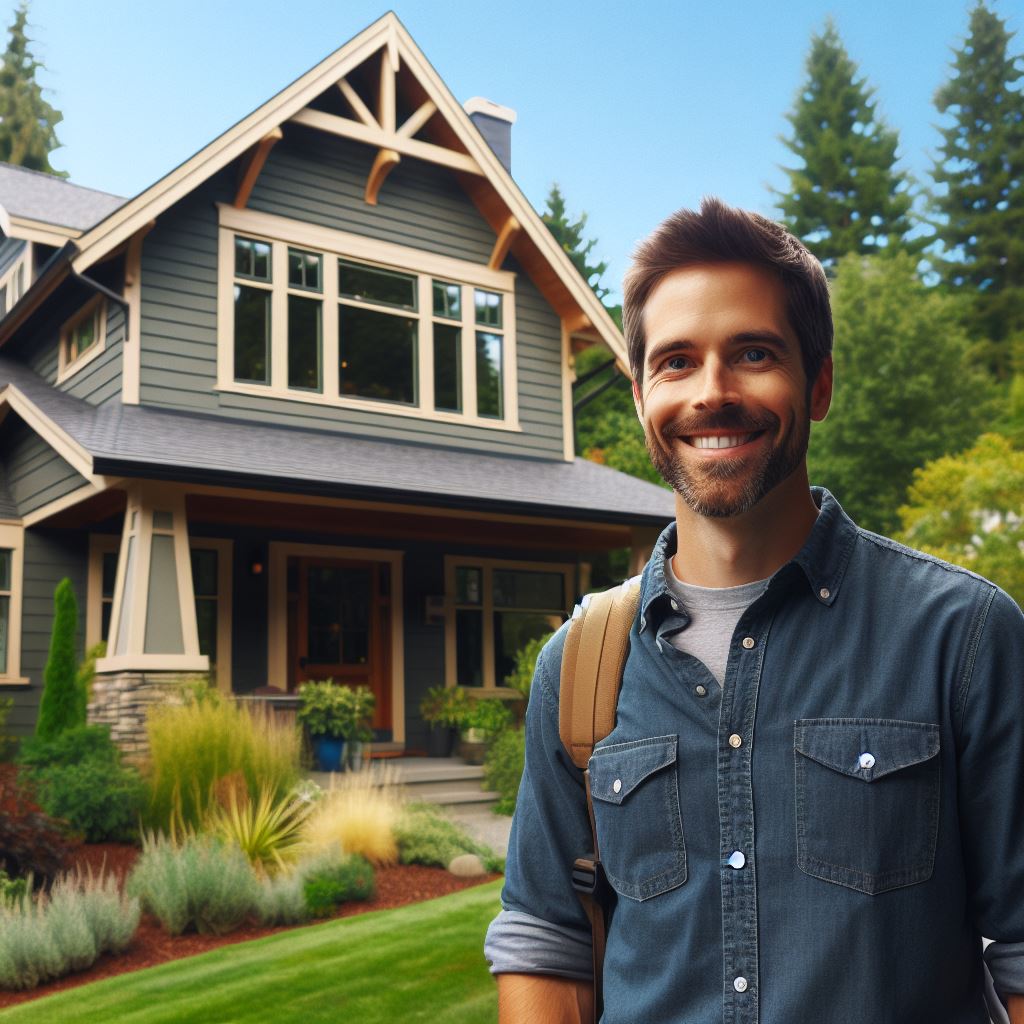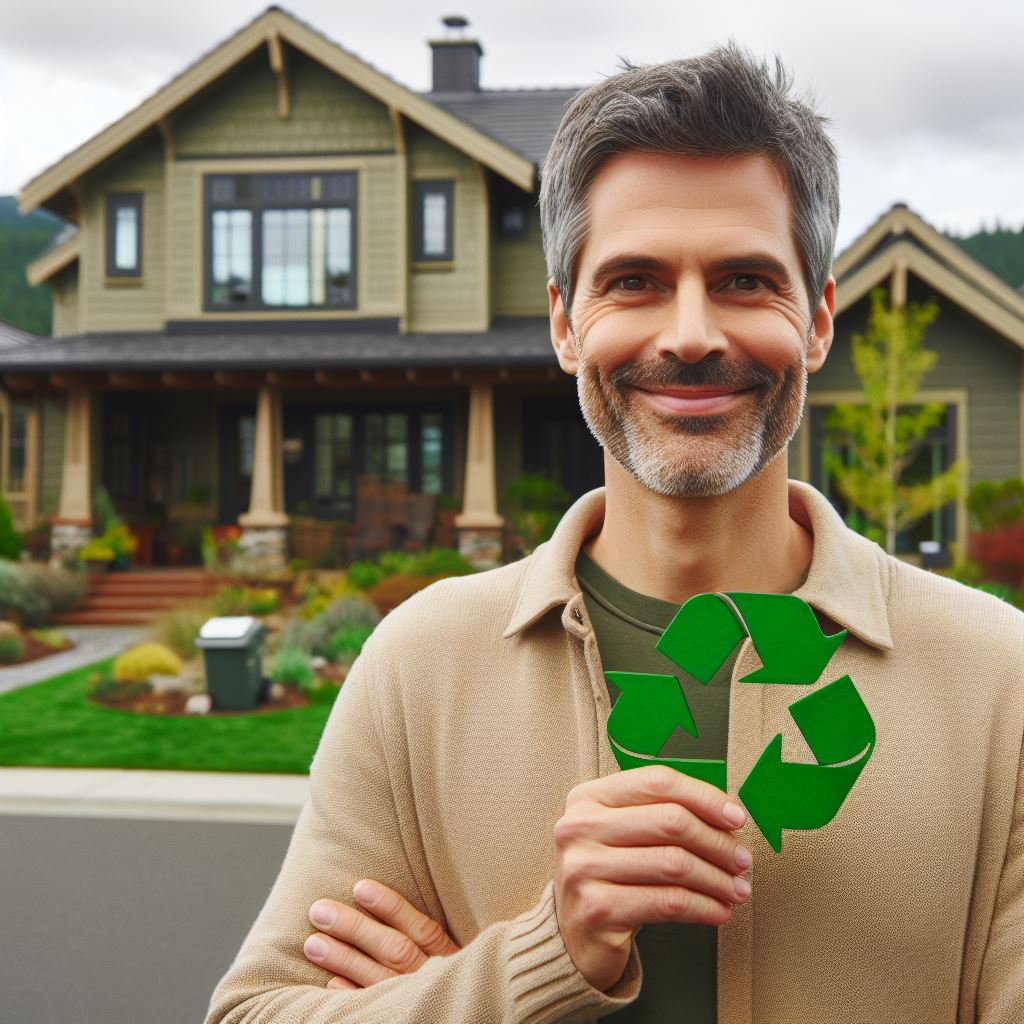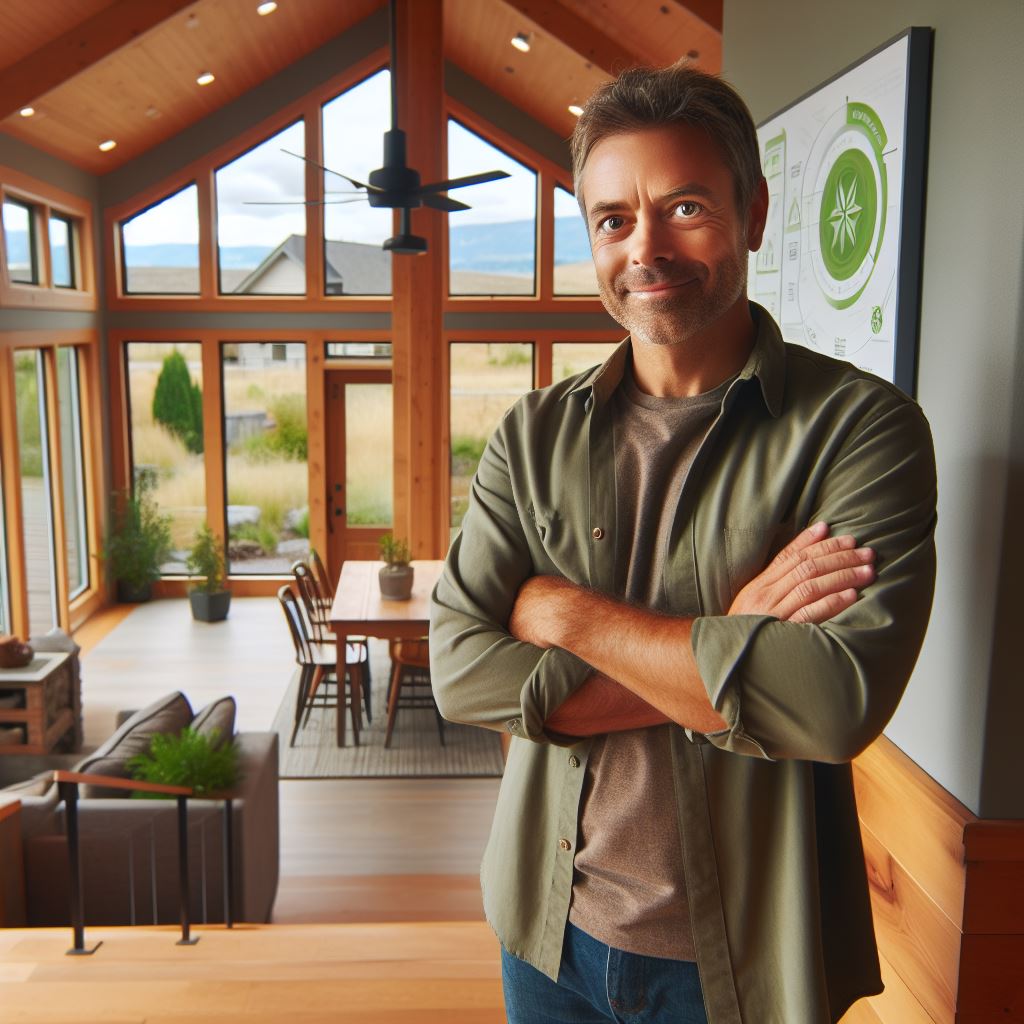Introduction
Oregon’s real estate market, characterized by its rich tapestry of landscapes ranging from lush forests to sprawling urban areas, stands as a testament to the state’s vibrant economy and diverse population.
With cities like Portland attracting a wave of newcomers seeking a blend of urban convenience and natural beauty, the demand for property in the Beaver State continues to soar.
However, amidst this flurry of real estate activity, there’s a growing recognition of the importance of sustainability in property development.
Oregonians have long prided themselves on their environmental consciousness, valuing practices that minimize ecological impact and promote long-term stewardship of the land.
In the realm of real estate, this translates into a keen interest in properties that are energy-efficient, utilize eco-friendly materials, and embrace principles of conservation and responsible land use.
Against this backdrop, this blog post sets out to explore Oregon’s path to sustainable property development.
From innovative green building initiatives to stringent environmental regulations, Oregon has emerged as a trailblazer in the realm of sustainable real estate practices.
By delving into the state’s unique approach to balancing growth with environmental preservation, we aim to uncover the strategies, policies, and partnerships driving this evolution towards a more sustainable future.
Through case studies, expert interviews, and analysis of current trends, we will shed light on the various facets of Oregon’s sustainable property landscape.
From residential developments to commercial ventures, from rural communities to urban revitalization projects, we’ll examine how sustainability is being woven into the fabric of Oregon’s built environment.
By understanding the successes, challenges, and lessons learned along the way, we hope to inspire and inform stakeholders across the real estate industry, both within Oregon and beyond.
Join us as we embark on this journey through Oregon’s dynamic and ever-evolving landscape of sustainable property development.
Historical Context of Sustainable Property Development in Oregon
Overview of Oregon’s Environmental Consciousness
Oregon has long been recognized as a pioneer in environmental consciousness and sustainable development practices.
The state’s commitment to preserving its natural resources and promoting sustainable living can be traced back to its early years.
Oregonians have always held a deep respect for their natural surroundings, with a strong conservation ethic ingrained in the state’s culture.
Transform Your Real Estate Decisions
Unlock personalized real estate insights crafted just for you. Get actionable advice designed to amplify your success.
Get StartedThis commitment is reflected in the numerous initiatives and regulations implemented over the years to protect the environment.
Early Initiatives and Regulations Promoting Sustainable Practices
One of the earliest initiatives promoting sustainable practices in Oregon was the creation of the Oregon Environmental Quality Commission in 1969.
This commission was tasked with developing policies and guidelines to ensure the conservation and protection of Oregon’s air, water, and land resources.
In the 1970s, the state introduced groundbreaking legislation such as the Oregon Land Conservation and Development Act.
This act aimed to manage urban growth and protect farmland, natural resources, and open spaces from unsuitable development.
Oregon also became one of the first states to adopt a comprehensive energy conservation code, further promoting sustainable building practices.
Additionally, the state has implemented stringent regulations on water usage, waste management, and air quality control to reduce environmental impact.
Examples of Sustainable Property Projects in Oregon
Oregon is home to numerous exemplary sustainable property projects that serve as models for environmentally friendly development.
The renowned Pearl District in Portland is a prime example of sustainable urban planning, featuring LEED-certified buildings, extensive public transit options, and green spaces.
The city also boasts innovative eco-districts, such as the South Waterfront District, which prioritize sustainable living and renewable energy sources.
In Bend, Oregon, the NorthWest Crossing residential community stands out for its commitment to sustainable design principles.
The development incorporates energy-efficient homes, walkable neighborhoods, and preserved natural landscapes.
Furthermore, Oregon showcases its dedication to sustainable property development through initiatives like the Oregon Sustainable Business Council.
This organization fosters collaboration between businesses to promote sustainable practices and support the green economy.
Showcase Your Real Estate Business
Publish your company profile on our blog for just $200. Gain instant exposure and connect with a dedicated audience of real estate professionals and enthusiasts.
Publish Your ProfileOverall, Oregon’s historical context of sustainable property development highlights the state’s commitment to environmental stewardship.
From early initiatives and regulations to ongoing sustainable projects, Oregon continues to pave the way for sustainable living and property development practices.
Read: Portland Real Estate: Eco-Friendly Investing
Current Sustainable Property Trends in Oregon
Government policies and regulations supporting sustainability
Oregon has emerged as a frontrunner in sustainable property trends, with several initiatives and practices that encourage environmentally-friendly development.
The state has implemented various government policies and regulations that support sustainability and push for eco-friendly practices.
Growth in green building certifications and programs
One of the key factors driving sustainable property trends is the growth in green building certifications and programs.
These certifications, such as LEED (Leadership in Energy and Environmental Design), provide guidelines for sustainable construction practices.
Developers are increasingly adopting these practices to create energy-efficient buildings that have minimal negative impacts on the environment.
Use of renewable energy sources in property development
In addition to certifications, the use of renewable energy sources in property development is gaining momentum in Oregon.
Solar panels, wind turbines, and geothermal energy systems are being incorporated into buildings, reducing reliance on traditional energy sources.
This shift towards renewable energy not only decreases the carbon footprint but also helps in achieving long-term energy cost savings.
Sustainable landscaping and water conservation practices
Another notable sustainable property trend in Oregon is the emphasis on sustainable landscaping and water conservation practices.
Developers are incorporating drought-tolerant plants and implementing efficient irrigation systems to minimize water usage.
Rainwater harvesting systems are also being utilized to capture and store rainwater, reducing reliance on traditional water sources.
The combination of these sustainable property trends has significant benefits for both the environment and property owners.
Energy-efficient buildings not only reduce greenhouse gas emissions but also lead to lower energy costs for occupants.
Incorporating renewable energy sources reduces reliance on fossil fuels and increases the overall energy independence of properties.
Sustainable landscaping and water conservation practices help preserve water resources and reduce the strain on municipal water supplies.
Additionally, they create aesthetically pleasing outdoor spaces that enhance the overall appeal and value of properties.
In essence, Oregon is witnessing a surge in sustainable property trends, driven by government support, green building certifications, renewable energy solutions, and sustainable landscaping practices.
These trends not only contribute to a greener future but also provide economic benefits for property owners.
By embracing sustainability in property development, Oregon is paving the way for a more environmentally-conscious and resilient real estate sector.
Read: Investing in Georgia’s Eco-Friendly Homes
Benefits of Sustainable Property Development in Oregon
Positive impact on the environment and natural resources
- Sustainable property development in Oregon promotes energy efficiency and reduces carbon emissions.
- By utilizing renewable energy sources, such as solar panels or geothermal systems, sustainable properties contribute less to air pollution.
- Implementing water conservation techniques, like rainwater harvesting and greywater systems, helps conserve precious water resources.
- Preserving natural habitats and utilizing green building materials aid in the protection of Oregon’s diverse ecosystem.
Health and well-being benefits for property occupants
- Sustainable properties in Oregon prioritize the health and well-being of their occupants.
- Incorporating ample natural lighting and proper ventilation reduces the risk of respiratory problems and enhances overall well-being.
- Using non-toxic building materials and low VOC paints improves indoor air quality and reduces the risk of allergies and respiratory illnesses.
- Access to green spaces and recreational areas promotes physical activity and mental well-being for property occupants.
Long-term cost savings for property owners
- Investing in sustainable property development in Oregon offers significant long-term cost savings.
- Energy-efficient appliances and insulation reduce utility bills and decrease dependence on fossil fuels.
- Water conservation measures result in lower water bills and help protect against future water scarcity.
- Minimal maintenance and upkeep costs due to durable, sustainable building materials increase cost savings for property owners.
Increased property value and market demand
- Sustainable properties in Oregon experience increased property value and higher market demand.
- As more individuals prioritize eco-friendly living, sustainable properties become highly sought-after in the real estate market.
- Green certifications, such as LEED or ENERGY STAR, enhance a property’s reputation and attract environmentally-conscious buyers.
- Investors recognize the long-term benefits and potential profitability of sustainable property development in Oregon.
In fact, sustainable property development in Oregon offers numerous benefits to the environment, property occupants, owners, and the real estate market.
By promoting energy efficiency and utilizing renewable resources, sustainable properties positively impact the environment and preserve natural resources.
Additionally, inhabitants of such properties experience improved health and well-being due to proper ventilation, natural lighting, and the use of non-toxic materials.
Moreover, property owners enjoy long-term cost savings through reduced utility bills and maintenance costs.
Lastly, sustainable properties have higher market demand and increased property value, making them a wise investment choice.
Overall, sustainable property development in Oregon is a win-win for all stakeholders involved.
Read: Green Construction: Colorado’s New Wave
Showcase Your Real Estate Business
Publish your company profile on our blog for just $200. Gain instant exposure and connect with a dedicated audience of real estate professionals and enthusiasts.
Publish Your Profile
Challenges and Solutions in Pursuing Sustainable Property Development
Construction and renovation costs associated with sustainability
One of the major challenges in pursuing sustainable property development is the higher construction and renovation costs associated with implementing sustainable practices.
These costs can be attributed to the use of eco-friendly materials, installation of energy-efficient systems, and incorporation of renewable energy sources.
However, these initial costs can be offset by long-term savings in energy consumption and maintenance expenses.
Additionally, government incentives and grants can help developers mitigate the financial burden of sustainable construction and renovation.
Limited availability of sustainable building materials
Another challenge is the limited availability of sustainable building materials in the market.
Many developers face difficulty in finding suppliers and manufacturers that offer eco-friendly alternatives to traditional materials.
To overcome this challenge, it is essential to promote the development and production of sustainable building materials.
Government regulations and incentives can encourage manufacturers to invest in the production of sustainable materials, making them more readily available for developers.
Overcoming resistance from traditional real estate developers
Traditional real estate developers may often resist the adoption of sustainable practices due to various reasons, including concerns about profitability and unfamiliarity with sustainable technologies.
To overcome this resistance, it is crucial to raise awareness about the economic and environmental benefits of sustainable property development.
Sharing success stories and showcasing the positive impact sustainable projects have on the community can help change perceptions and encourage more developers to embrace sustainability.
Collaboration and innovation to overcome challenges
The challenges faced in pursuing sustainable property development can be effectively addressed through collaboration and innovation.
Developers, architects, engineers, and policymakers need to work together to find solutions and overcome obstacles.
Collaborative platforms and networks can be established to facilitate knowledge sharing and encourage innovation in sustainable practices.
By working together, professionals can identify and implement new technologies, design strategies, and financing models that make sustainable development more accessible and cost-effective.
In short, pursuing sustainable property development presents several challenges requiring innovative solutions.
Cost considerations, limited availability of sustainable materials, resistance from traditional developers, and collaboration are key areas to focus on in order to overcome these obstacles.
By addressing these challenges head-on, Oregon can continue on its path to creating a more sustainable and environmentally-friendly built environment for future generations.
Read: Philadelphia Market: Historical Home Profits
Case Studies: Successful Sustainable Property Projects in Oregon
In Oregon, several notable sustainable property projects have effectively demonstrated the state’s commitment to environmental responsibility and community impact.
These case studies highlight the successful implementation of sustainable strategies, showcasing the positive outcomes and benefits they bring.
Notable sustainable property developments in the state
The South Waterfront District in Portland stands out as a remarkable sustainable property development.
Formerly abandoned industrial land, it has transformed into a thriving mixed-use community.
Utilizing green building practices, the district achieved LEED certification, ensuring energy efficiency and reduced environmental impact.
Its thoughtfully designed structures and stormwater management systems have also contributed to a healthier urban environment.
Another remarkable sustainable property project is the Hood River Middle School, which serves as a model for educational institutions.
The school implemented various sustainable strategies, including solar panels for renewable energy generation, a rainwater harvesting system, and a living roof.
These features not only reduce the carbon footprint of the campus but also provide students with an immersive learning experience in environmental conservation.
The Tillamook Creamery stands as a shining example of sustainable practices within the food industry.
The creamery has implemented energy-efficient equipment, waste reduction initiatives, and a biogas digester.
Showcase Your Real Estate Business
Publish your company profile on our blog for just $200. Gain instant exposure and connect with a dedicated audience of real estate professionals and enthusiasts.
Publish Your ProfileThis innovative digester converts cow waste into renewable energy, significantly reducing greenhouse gas emissions.
These sustainable measures have not only improved the creamery’s environmental impact but have also increased its appeal among environmentally conscious consumers.
Positive outcomes and community impact
The positive outcomes and community impact resulting from these sustainable property projects are significant.
The South Waterfront District has revitalized the area, attracting residents, businesses, and tourists.
This development has led to economic growth, job creation, and a more livable urban environment.
Similarly, the Hood River Middle School’s sustainable features have inspired other educational institutions to adopt similar initiatives, promoting environmental education and awareness among students.
Furthermore, the Tillamook Creamery’s commitment to sustainability has enhanced its brand reputation.
Consumers who prioritize environmentally friendly products are more likely to choose Tillamook’s products, bringing economic benefits to the creamery.
Additionally, the reduction in greenhouse gas emissions from the biogas digester highlights the creamery’s commitment to combatting climate change.
In general, Oregon’s sustainable property projects serve as valuable examples of successful implementation and community impact.
The South Waterfront District, Hood River Middle School, and Tillamook Creamery have all demonstrated unique features and strategies that contribute to sustainability.
These case studies emphasize the importance of integrating sustainable practices into property developments to create environmental, economic, and social benefits for communities.
Future Outlook for Sustainable Property in Oregon
In this section, we will discuss the potential growth and expansion of sustainable practices, anticipated changes in government policies and regulations, and the technologies and innovations shaping the future of sustainable property in Oregon.
Potential growth and expansion of sustainable practices
Oregon has become a leader in sustainable property practices, and the momentum is expected to continue.
There is a growing demand for sustainable properties as consumers are becoming more environmentally conscious.
Future growth will likely be driven by the integration of sustainable practices into new construction and renovation projects.
Green building certifications such as LEED and ENERGY STAR will play a crucial role in promoting sustainable property development.
Real estate developers and investors are recognizing the financial benefits of sustainable properties, further driving their growth.
Anticipated changes in government policies and regulations
The Oregon state government is expected to continue implementing policies that incentivize sustainable property practices.
There may be stricter regulations on energy efficiency standards, waste management, and water conservation in the future.
Government incentives such as tax credits and grants will encourage property owners to adopt sustainable practices.
Policy changes could also include requirements for the use of renewable energy sources in new construction and renovations.
Collaboration between the government, industry stakeholders, and environmental organizations will shape future policies.
Technologies and innovations shaping the future of sustainable property
Advancements in renewable energy technologies, such as solar panels and wind turbines, will greatly impact sustainable property development.
Smart home automation systems will become more prevalent, allowing for efficient energy management and reduced consumption.
Emerging technologies like building-integrated photovoltaics and geothermal heating systems will revolutionize sustainable property design.
Innovative construction materials, such as recycled and locally sourced materials, will be widely used to improve sustainability.
Internet of Things (IoT) devices will enable real-time monitoring and optimization of energy usage in sustainable properties.
In a nutshell, the future outlook for sustainable property in Oregon is promising.
With increasing demand, government support, and advancements in technologies, the growth and expansion of sustainable practices are inevitable.
Showcase Your Real Estate Business
Publish your company profile on our blog for just $200. Gain instant exposure and connect with a dedicated audience of real estate professionals and enthusiasts.
Publish Your ProfileOregon’s commitment to sustainability will continue to shape the state’s real estate industry for years to come.
Conclusion
Oregon’s path to sustainable property has been a journey characterized by proactive legislation and robust community engagement.
Through the implementation of forward-thinking policies and concerted efforts from various stakeholders, the state has made significant strides towards promoting environmental stewardship and responsible land development practices.
Emphasizing the significance of sustainable practices in property development is paramount in today’s rapidly evolving landscape.
Beyond the immediate benefits of reducing carbon emissions and preserving natural resources, sustainable property initiatives contribute to long-term economic resilience, enhancing property value and mitigating risks associated with climate change and environmental degradation.
By prioritizing sustainability, stakeholders not only safeguard the environment but also ensure the viability and attractiveness of properties for future generations.
As we reflect on Oregon’s journey, it is clear that the collective efforts of individuals, businesses, and policymakers play a pivotal role in shaping the trajectory of sustainable real estate development.
Therefore, it is incumbent upon all stakeholders to continue advocating for and implementing sustainable practices in real estate.
By supporting initiatives such as green building certifications, renewable energy integration, and sustainable land use planning, we can collectively drive positive change and foster resilient communities.
Furthermore, it is essential to educate and empower individuals to make informed decisions that prioritize sustainability in their real estate endeavors.
Whether through supporting sustainable development projects, incorporating energy-efficient technologies into existing properties, or advocating for policy reforms, each action contributes to the larger goal of building a more sustainable future.
Oregon’s journey towards sustainable property serves as a beacon of inspiration and a testament to the transformative power of collective action.
By embracing sustainability in real estate, we not only safeguard the natural environment but also create thriving communities and unlock economic opportunities for generations to come.
Let us continue to support and promote sustainability in real estate, ensuring a brighter and more sustainable future for all.




